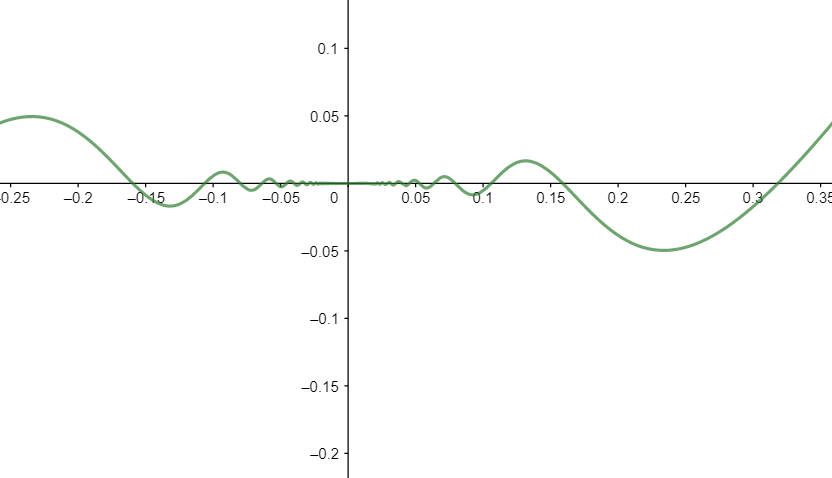
Discuss the continuity of the function $f\left( x \right)=\left\{ \begin{matrix}
{{x}^{2}}\sin \left( \dfrac{1}{x} \right),x\ne 0 \\
0,\text{ }x=0 \\
\end{matrix} \right.$ at x=0.
Answer
495.6k+ views
Hint: Use the fact that if a function f(x) is continuous at a point, then the left hand limit and the right hand limit at that point are equal and are equal to the value of the function at that point. Hence, we have $f\left( x \right)$ is continuous at x= a if $\underset{x\to {{a}^{-}}}{\mathop{\lim }}\,f\left( x \right)=\underset{x\to {{a}^{+}}}{\mathop{\lim }}\,f\left( x \right)=f\left( a \right)$. Hence find the left hand limit and the right hand limit at x= 0. Verify if the limits are equal or not. Check if the limits are equal and are they equal to the functional value and hence verify whether f(x) is continuous at x =0. Use the fact that $\underset{x\to 0}{\mathop{\lim }}\,x\sin \left( \dfrac{1}{x} \right)=0$ and use \[\underset{x\to {{a}^{-}}}{\mathop{\lim }}\,f\left( x \right)=\underset{h\to 0}{\mathop{\lim }}\,f\left( a-h \right)\] and $\underset{x\to {{a}^{+}}}{\mathop{\lim }}\,f\left( x \right)=\underset{h\to 0}{\mathop{\lim }}\,f\left( a+h \right)$ and hence find LHL and RHL.
Complete step-by-step answer:
We have $f\left( x \right)=\left\{ \begin{matrix}
{{x}^{2}}\sin \left( \dfrac{1}{x} \right),x\ne 0 \\
0,\text{ }x=0 \\
\end{matrix} \right.$
Now, we have
LHL $=\underset{x\to {{0}^{-}}}{\mathop{\lim }}\,f\left( x \right)=\underset{h\to 0}{\mathop{\lim }}\,f\left( 0-h \right)$
Hence, we have
LHL $=\underset{h\to 0}{\mathop{\lim }}\,f\left( -h \right)=\underset{h\to 0}{\mathop{\lim }}\,{{\left( -h \right)}^{2}}\sin \left( \dfrac{-1}{h} \right)=\underset{h\to 0}{\mathop{\lim }}\,{{h}^{2}}\sin \left( \dfrac{-1}{h} \right)$
We know that $\underset{h\to 0}{\mathop{\lim }}\,h\sin \left( \dfrac{1}{h} \right)=0$
Hence, we have LHL $=\underset{h\to 0}{\mathop{\lim }}\,\left( -h \right)\underset{h\to 0}{\mathop{\lim }}\,h\sin \left( \dfrac{1}{h} \right)=0\times 0=0$
Now, RHL $=\underset{x\to {{0}^{+}}}{\mathop{\lim }}\,f\left( x \right)=\underset{h\to 0}{\mathop{\lim }}\,f\left( 0+h \right)$
Hence, we have
RHL $=\underset{h\to 0}{\mathop{\lim }}\,f\left( h \right)=\underset{h\to 0}{\mathop{\lim }}\,{{h}^{2}}\sin \left( \dfrac{1}{h} \right)$
We know that $\underset{h\to 0}{\mathop{\lim }}\,h\sin \left( \dfrac{1}{h} \right)=0$
Hence, we have RHL $=\underset{h\to 0}{\mathop{\lim }}\,h\times \underset{h\to 0}{\mathop{\lim }}\,h\sin \left( \dfrac{1}{h} \right)=0\times 0=0$
Hence LHL = RHL = 0.
Also f(0) = 0.
Hence, we have
LHL = RHL = f(0).
Hence, the function is continuous at x=0.
Note: Graph of f(x):

As can be seen from the graph of f(x), f(x) is continuous at x=0.
[2] Alternative solution:
We know that if f(x) is continuous at x =a, then $\forall \varepsilon >0$ there exists $\delta >0$ such that $\left| f\left( x \right)-f\left( a \right) \right|<\varepsilon $, whenever $\left| x-a \right|<\delta $.
We have $f\left( x \right)=\left\{ \begin{matrix}
{{x}^{2}}\sin \left( \dfrac{1}{x} \right),x\ne 0 \\
0,\text{ }x=0 \\
\end{matrix} \right.$
Claim: f(x) is continuous at x=0.
We have $\left| f\left( x \right)-f\left( a \right) \right|=\left| {{x}^{2}}\sin \left( \dfrac{1}{x} \right)-0 \right|=\left| {{x}^{2}}\sin \left( \dfrac{1}{x} \right) \right|$
Since $\sin \left( \dfrac{1}{x} \right)\le 1$, we have $\left| {{x}^{2}}\sin \left( \dfrac{1}{x} \right) \right|\le \left| {{x}^{2}} \right|\le {{\left| x \right|}^{2}}$.
Hence $\forall \varepsilon >0\exists \delta =\sqrt{\varepsilon }>0$ such that whenever $\left| x-0 \right|<\delta \Rightarrow \left| {{x}^{2}} \right|<\varepsilon \Rightarrow \left| {{x}^{2}}\sin \left( \dfrac{1}{x} \right)-0 \right|<\varepsilon $.
Hence f(x) is continuous at x= 0.
Complete step-by-step answer:
We have $f\left( x \right)=\left\{ \begin{matrix}
{{x}^{2}}\sin \left( \dfrac{1}{x} \right),x\ne 0 \\
0,\text{ }x=0 \\
\end{matrix} \right.$
Now, we have
LHL $=\underset{x\to {{0}^{-}}}{\mathop{\lim }}\,f\left( x \right)=\underset{h\to 0}{\mathop{\lim }}\,f\left( 0-h \right)$
Hence, we have
LHL $=\underset{h\to 0}{\mathop{\lim }}\,f\left( -h \right)=\underset{h\to 0}{\mathop{\lim }}\,{{\left( -h \right)}^{2}}\sin \left( \dfrac{-1}{h} \right)=\underset{h\to 0}{\mathop{\lim }}\,{{h}^{2}}\sin \left( \dfrac{-1}{h} \right)$
We know that $\underset{h\to 0}{\mathop{\lim }}\,h\sin \left( \dfrac{1}{h} \right)=0$
Hence, we have LHL $=\underset{h\to 0}{\mathop{\lim }}\,\left( -h \right)\underset{h\to 0}{\mathop{\lim }}\,h\sin \left( \dfrac{1}{h} \right)=0\times 0=0$
Now, RHL $=\underset{x\to {{0}^{+}}}{\mathop{\lim }}\,f\left( x \right)=\underset{h\to 0}{\mathop{\lim }}\,f\left( 0+h \right)$
Hence, we have
RHL $=\underset{h\to 0}{\mathop{\lim }}\,f\left( h \right)=\underset{h\to 0}{\mathop{\lim }}\,{{h}^{2}}\sin \left( \dfrac{1}{h} \right)$
We know that $\underset{h\to 0}{\mathop{\lim }}\,h\sin \left( \dfrac{1}{h} \right)=0$
Hence, we have RHL $=\underset{h\to 0}{\mathop{\lim }}\,h\times \underset{h\to 0}{\mathop{\lim }}\,h\sin \left( \dfrac{1}{h} \right)=0\times 0=0$
Hence LHL = RHL = 0.
Also f(0) = 0.
Hence, we have
LHL = RHL = f(0).
Hence, the function is continuous at x=0.
Note: Graph of f(x):

As can be seen from the graph of f(x), f(x) is continuous at x=0.
[2] Alternative solution:
We know that if f(x) is continuous at x =a, then $\forall \varepsilon >0$ there exists $\delta >0$ such that $\left| f\left( x \right)-f\left( a \right) \right|<\varepsilon $, whenever $\left| x-a \right|<\delta $.
We have $f\left( x \right)=\left\{ \begin{matrix}
{{x}^{2}}\sin \left( \dfrac{1}{x} \right),x\ne 0 \\
0,\text{ }x=0 \\
\end{matrix} \right.$
Claim: f(x) is continuous at x=0.
We have $\left| f\left( x \right)-f\left( a \right) \right|=\left| {{x}^{2}}\sin \left( \dfrac{1}{x} \right)-0 \right|=\left| {{x}^{2}}\sin \left( \dfrac{1}{x} \right) \right|$
Since $\sin \left( \dfrac{1}{x} \right)\le 1$, we have $\left| {{x}^{2}}\sin \left( \dfrac{1}{x} \right) \right|\le \left| {{x}^{2}} \right|\le {{\left| x \right|}^{2}}$.
Hence $\forall \varepsilon >0\exists \delta =\sqrt{\varepsilon }>0$ such that whenever $\left| x-0 \right|<\delta \Rightarrow \left| {{x}^{2}} \right|<\varepsilon \Rightarrow \left| {{x}^{2}}\sin \left( \dfrac{1}{x} \right)-0 \right|<\varepsilon $.
Hence f(x) is continuous at x= 0.
Recently Updated Pages
Master Class 11 English: Engaging Questions & Answers for Success

Master Class 11 Computer Science: Engaging Questions & Answers for Success

Master Class 11 Maths: Engaging Questions & Answers for Success

Master Class 11 Social Science: Engaging Questions & Answers for Success

Master Class 11 Economics: Engaging Questions & Answers for Success

Master Class 11 Business Studies: Engaging Questions & Answers for Success

Trending doubts
10 examples of friction in our daily life

What problem did Carter face when he reached the mummy class 11 english CBSE

One Metric ton is equal to kg A 10000 B 1000 C 100 class 11 physics CBSE

Difference Between Prokaryotic Cells and Eukaryotic Cells

State and prove Bernoullis theorem class 11 physics CBSE

The sequence of spore production in Puccinia wheat class 11 biology CBSE




